
Amber is fossilized tree resin that has been appreciated for its color and natural beauty since Neolithic times. Much valued from antiquity to the present as a gemstone, amber is made into a variety of decorative objects. Amber is used in jewelry and has been used as a healing agent in folk medicine.

Panarthropoda is a proposed animal clade containing the extant phyla Arthropoda, Tardigrada and Onychophora. Panarthropods also include extinct marine legged worms known as lobopodians ("Lobopodia"), a paraphyletic group where the last common ancestor and basal members (stem-group) of each extant panarthropod phylum are thought to have risen. However the term "Lobopodia" is sometimes expanded to include tardigrades and onychophorans as well.

Dominican amber is amber from the Dominican Republic derived from resin of the extinct tree Hymenaea protera.
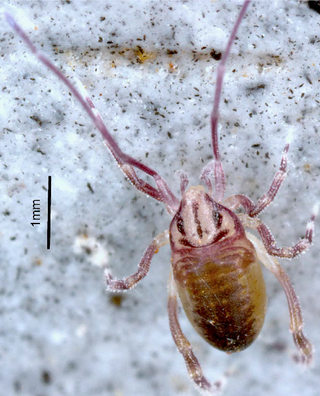
Opilioacaridae is the sole family of mites in the order Opilioacarida, made up of about 13 genera. The mites of this family are rare, large mites, and are widely considered primitive, as they retain six pairs of eyes, and abdominal segmentation. They have historically been considered separate from other mites belonging to Acariformes and Parasitiformes, but are now generally considered a subgroup of Parasitiformes based on molecular phylogenetics.

Evaniidae is a family of parasitoid wasps also known as ensign wasps, nightshade wasps, hatchet wasps, or cockroach egg parasitoid wasps. They number around 20 extant genera containing over 400 described species, and are found all over the world except in the polar regions. The larvae of these solitary wasps are parasitoids that feed on cockroaches and develop inside the egg-cases, or oothecae, of their hosts.

Tardigrades, known colloquially as water bears or moss piglets, are a phylum of eight-legged segmented micro-animals. They were first described by the German zoologist Johann August Ephraim Goeze in 1773, who called them Kleiner Wasserbär. In 1777, the Italian biologist Lazzaro Spallanzani named them Tardigrada, which means "slow steppers".
Paleoparasitology is the study of parasites from the past, and their interactions with hosts and vectors; it is a subfield of Paleontology, the study of living organisms from the past. Some authors define this term more narrowly, as "Paleoparasitology is the study of parasites in archaeological material." (p. 103) K.J. Reinhard suggests that the term "archaeoparasitology" be applied to "... all parasitological remains excavated from archaeological contexts ... derived from human activity" and that "the term 'paleoparasitology' be applied to studies of nonhuman, paleontological material." (p. 233) This article follows Reinhard's suggestion and discusses the protozoan and animal parasites of non-human animals and plants from the past, while those from humans and our hominid ancestors are covered in archaeoparasitology.

Triatoma dominicana is an extinct species of assassin bug in the subfamily Triatominae, the kissing bugs known from early Miocene Burdigalian stage Dominican amber deposits on the island of Hispaniola.

Trypanosoma antiquus is an extinct species of kinetoplastid, a monophyletic group of unicellular parasitic flagellate protozoa.
Eickwortapis is an extinct monotypic genus of sweat bee in the Halictidae subfamily Halictinae which contains the single species Eickwortapis dominicana.
Palaeoraphe is an extinct genus of palms, represented by one species, Palaeoraphe dominicana from early Miocene Burdigalian stage Dominican amber deposits on the island of Hispaniola, in the modern-day Dominican Republic.
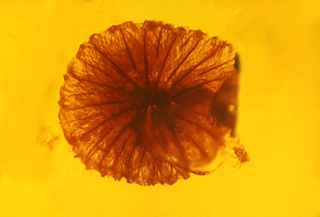
Coprinites is an extinct monotypic genus of gilled fungus in the Agaricales family Agaricaceae. At present it contains the single species Coprinites dominicana.
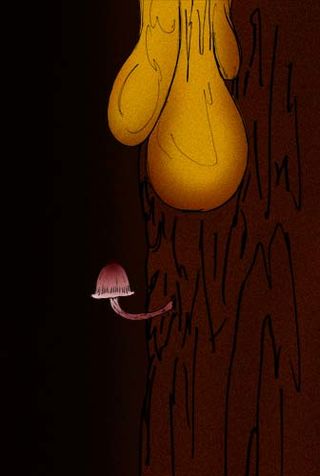
Protomycena is an extinct monotypic genus of gilled fungus in the family Mycenaceae, of order Agaricales. At present it contains the single species Protomycena electra, known from a single specimen collected in an amber mine in the Cordillera Septentrional area of the Dominican Republic. The fruit body of the fungus has a convex cap that is 5 mm (0.2 in) in diameter, with distantly spaced gills on the underside. The curved stipe is smooth and cylindrical, measuring 0.75 mm (0.030 in) thick by 10 mm (0.39 in) long, and lacks a ring. It resembles extant species of the genus Mycena. Protomycena is one of only five known agaric fungus species known in the fossil record and the second to be described from Dominican amber.
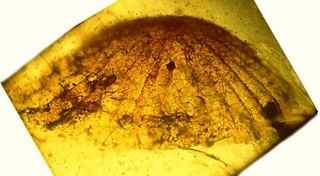
Palaeoagaracites is an extinct monotypic genus of gilled fungus in the order Agaricales. It contains the single species Palaeoagaracites antiquus.

Vetufebrus is an extinct genus of haemospororida in the family Plasmodiidae. At the time of its description the new genus comprised a single species Vetufebrus ovatus known from a single Miocene Dominican amber fossil found on Hispaniola. V. ovatus was vectored by Enischnomyia stegosoma, the first fossil streblid bat fly described from a fossil, and the only member of the subfamily Nycterophiliinae described from Hispaniola. V. ovatus is the first instance of a Streblidae bat fly as a host for a malarial parasite.
Pseudarmadillo cristatus is an extinct species of isopod (woodlouse) in the family Delatorreiidae known from a series of possibly Miocene fossils found on Hispaniola. At the time of description P. cristatus was one of two Pseudarmadillo species known from the fossil record and one of only two from Hispaniola.

Aphaenogaster amphioceanica is an extinct species of ant in the subfamily Myrmicinae known from a single possibly Miocene fossil found in amber on Hispaniola. At the time of description A. amphioceanica was one of two Aphaenogaster species known from the Caribbean islands.
The La Toca Formation is a geologic formation in the northern and eastern part of the Dominican Republic. The formation, predominantly an alternating sequence of marls and turbiditic sandstones, breccias and conglomerates, is renowned for the preservation of insects and other arthropods in amber, known as Dominican amber. The formation is dated to the Burdigalian to Langhian stages of the Miocene period.
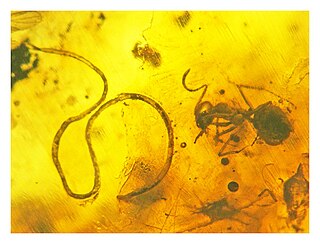
Heydenius is a collective group genus of fossil mermithid nematodes from the Tertiary period that cannot be placed in extant genera.

Enischnomyia is an extinct genus of bat fly in the family Streblidae. At the time of its description the new genus comprised a single species, Enischnomyia stegosoma, known from a single Miocene fossil found on Hispaniola. E. stegosoma was the first fossil streblid bat fly described from a fossil, and the only member of the subfamily Nycterophiliinae described from Hispaniola. The species is host for the plasmodiid Vetufebrus ovatus preserved in its salivary glands and midgut.















